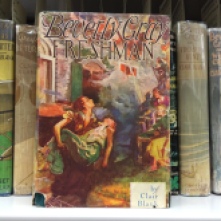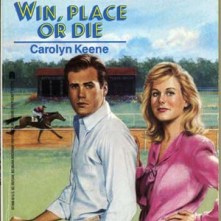
“Nixon Drinks Ripple” and “Nixon Eats Lettuce” seem like rather innocuous statements. Without context, they do not seem like accusation or criticism. But these United Farm Worker pins displaying political cartoons of Nixon, claiming that he “Drinks Ripple” and “Eats Lettuce,” are the United Farm Workers’ condemnation of President Nixon for not supporting their strikes for better wages and working conditions. The farm workers initially went on a grape strike in 1965 and subsequently staged a national consumer boycott of all grape products. They staged additional grape and lettuce strikes in the 70s.
Nixon was not a friend to the United Farm Workers (UFW). Famously anti-union, Nixon did nothing to support them and at times actively worked against them. In the 1950s, he helped to exclude farm workers from national labor relations legislation. As part of his 1968 campaign, he publicly “denounced the California grape boycott.” The farm workers saw him as their opponent. This is why there are pins and posters attacking the disgraced president with phrases such as “Nixon Drinks Ripple,”
Under the Nixon administration, The U.S. Department of Defense also became an enemy of the United Farm Workers because of the Vietnam War and their active attempts to thwart the strike.
From the beginning, the UFW claimed they “always opposed the war.”1 In October 1969, the organization officially stated in their publication El Malcriado that they were joining anti-war protests. This followed Ceaser Chavez, director of UFW, joining other “prominent Americans in calling for an end to the war.”2 As a movement dedicated to nonviolence and inspired by other social movements of the 60s, anti-war protests were aligned with the United Farm Workers beliefs. The farm worker’s community, as Chavez points out, was also heavily victimized by the Vietnam draft and the subsequent loss of life. In the same article in El Malcriado, the UFW cites a study done by UC Santa Cruz that revealed “Mexican Americans make up more than 20% of the casualties of Americans from the southwestern states.”3 As a community that often doesn’t have the privilege of college, they are are not able to use the main draft deferment.

A lot of the farm workers’ rhetoric and messaging called out the forces funding and supporting the war. For example, the UFW used the phrase “Napalm & lettuce – Dow supplies both” to call out the partnership of the grower Antle and Dow chemicals. Dow is a chemical supplier who worked with various growers to supply the pesticides used in the fields. Dow also supplied the Napalm that was horrifically used as a chemical weapon in Vietnam. This slogan, “Napalm and Lettuce,” calls out chemical supplier’s involvement in the war. They were condemning Dow Chemicals, linking their involvement in the war with their involvement in the strike. Furthermore, as seen here, the farm workers drew comparisons between the injustices in the Vietnam War and in California’s fields. The cover design for an issue of El Malcriado was an image of an armed guard watching over strikebreakers in the fields of Salinas Valley with the title “Why Vietnam When There Is A Salinas.” The farm workers were engaging with the Vietnam war on a moral level, utilizing a negative connotation of the war to condemn similarities with their own struggle.

Opposition to the war was also political for the UFW. The Department of Defense was buying grapes from the list of boycotted growers to feed soldiers in Vietnam, effectively crossing the picket line. While the Department of Defense exporting grapes was not unheard of, the purchases of scab grapes by the Department of Defense skyrocketed during the strike. The political cartoon “You Know We Gotta Be Neutral” calls out this practice, poking fun at the Department of Defense for even pretending to be neutral. The purchase of grapes was the worst under the Nixon Administration. By October of his first year in office, there was a “300% increase in the purchase of table grapes.”4 In 1968, 555,000 lbs of grapes were purchased by the DoD for export to Vietnam. In 1969, the first year of Nixon’s presidency, that number jumped to 4 million. While the DoD tried to defend themselves saying that this was an impartial decision made on the basis of efficiency and availability, there is no denying these numbers, especially under Nixon.


Protest in front of the DoD; copywrite University of Maryland; AFL-CIO Information Department, Special Collections and University Archives; University of Maryland.
Ending this targeted purchase of grapes by the government became a part of the farm workers’ agenda. The UFW organized demonstrations in front of the DoD, demanding an end to this purchasing practice as seen in the pictures on the left. Chavez said during a press conference that “if it hadn’t been for these huge purchases of grapes by the Federal Government and its Department of Defense, this strike would have been settled by now.”5 Additionally, in 1971, the UFW took this issue to court. When the farm workers were engaged in a lettuce and grape strike and lettuce was on the list of boycotted goods, Chavez announced that the “union sued the Department of Defense to prohibit the army from buying lettuce.”
The farm workers faced a lot of opposition in their struggle for collective bargaining, adequate wages and safe working conditions. These barriers were only strengthened as powerful forces such as the Nixon Administration and the Department of Defense were at odds with the UFW. Despite this adversity, the farm workers signed their first round of successful contracts in 1970 and became a recognized AFL-CIO union in 1972. These wins gave the farm workers better wages, conditions and collective bargaining power. While the UFW made progress in the 1960s and 1970s, the plight of farm workers is far from over and exploitation still continues today.
Evelyn Reidy is a student in the College Park Scholars Justice and Legal Thought program and completed this project and exhibition as her CPJT230 Capstone.
- UFWOC Joins War Protests – El Malcriado Vol. III 1969; copyright University of Maryland; El Malcriado; United Farm Workers Publications; Special Collections and University Archives, University of Maryland Libraries. ↩︎
- UFWOC Joins War Protests – El Malcriado Vol. III 1969; copyright University of Maryland; El Malcriado; United Farm Workers Publications; Special Collections and University Archives, University of Maryland Libraries. ↩︎
- UFWOC Joins War Protests – El Malcriado Vol. III 1969; copyright University of Maryland; El Malcriado; United Farm Workers Publications; Special Collections and University Archives, University of Maryland Libraries. ↩︎
- Prevent Strike Settlement Chavez: Pentagon Grape Purchases – El Malcriado Vol. III 1969; copyright University of Maryland; El Malcriado; United Farm Workers Publications; Special Collections and University Archives, University of Maryland Libraries. ↩︎
- Prevent Strike Settlement Chavez: Pentagon Grape Purchases – El Malcriado Vol. III 1969; copyright University of Maryland; El Malcriado; United Farm Workers Publications; Special Collections and University Archives, University of Maryland Libraries. ↩︎



 If you would like to talk to us about using our collections for your own research or to support your instruction, please let us know. We often work with faculty and look forward to the opportunity to get to know you and your students.
If you would like to talk to us about using our collections for your own research or to support your instruction, please let us know. We often work with faculty and look forward to the opportunity to get to know you and your students.














































